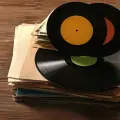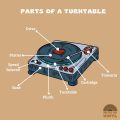If we are unfamiliar with the world of vinyl record collecting and the inherent logic within, then all of the numbers and glyphs can seem awfully frightening and overwhelming. Why can’t we just take our vinyl record types and play them, for crying out loud?!
But what if we were to play our new vinyl records too fast? What if we had David Bowie sounding like Alvin and the Chipmunks instead of his usual commanding self? And exactly what are vinyl record types all about?
As with plenty of numerical symbolism throughout the Western world, the numbers outlined on vinyl records give us a deep clue about their very nature. In this instance, they tend to tell us just how a vinyl record should be played if we want it to sound as close as possible to its intended release.
But why are there even different ways to play a vinyl record? Why are there different formats and different speeds at which we play vinyl records, and what do the numbers mean on vinyl records?
Table of Contents
Types of Vinyl Records
Vinyl records are categorized based on their size, speed (measured in revolutions per minute, or RPM), and the amount of music they can hold. Here are the main types:
7-inch Records: These records are typically played at 45 RPM. They are also known as singles because they often contain one song on each side. The 7-inch 45 RPM record was introduced in the late 1940s by RCA as a more durable and higher-fidelity alternative to the 78 RPM shellac records.
10-inch Records: These can be found in both 78 RPM (older records) and 33⅓ RPM (more modern LPs, EPs, or albums). The 10-inch 78 RPM records were standard before the 1950s, mainly for single songs or a few short pieces. The 10-inch 33⅓ RPM records are less common and typically used for shorter albums or EPs.
12-inch Records: These are the standard size for LP (Long Play) albums and are typically played at 33⅓ RPM. Introduced by Columbia Records in 1948, 12-inch LPs can hold more music than the older formats—up to about 22 minutes per side. The 12-inch size at 45 RPM is also used for maxi-singles, providing higher audio quality for dance and electronic music.
Vinyl Record Types Based on Speed
A first point to clear up in our mission to elucidate the various vinyl record types is the fact that there are several speeds at which these vinyl records are typically played. These days these speeds tend to boil down to just two, though there are some turntables that give you the ability to fine-tune the speed at which a record is played, giving you far more possibilities than simply these two (33 1/3 rpm and 45 rpm).
A turntable spins, clearly, and this spinning is measured in speed as revolutions per minute. There are typically only two speeds like this, as elucidated above, though some more specialist and high range turntables offer the ability to play at 78 rpm, just as would have been popular at the dawn of the record industry.
78 RPM
Of the three primary speeds at which to play vinyl record types, this is certainly the least popular and fashionable, with rarely any manufacturers catering for this speed in any of its productions. Records, by whatever logic, have better sound quality the faster they are played, the faster the RPM at which they are playing. In turn, a faster RPM means there will inherently be less space on the disc for music to play back; whether or not this is a worthy sacrifice is constantly up for debate between those more contentious vinyl enthusiasts.
The inventor of the Gramophone record, Emile Berliner, created records that were played between 70 and 80 RPM, a precedent which was followed pretty strictly to the point where 78 RPM became the industry standard throughout the Western world by 1925. While the sizes of these original 78 RPM records vary, they were typically rendered on 10-inch records so as to accommodate for the shorter playback time, eventually becoming the standard size for records played at this speed.
This soon became a fairly unpopular form for music to be released upon, not just for the less than adequate playback time offered. The material used to make records of this variety was found to be more brittle and prone to shattering, an issue not just for the commercial prospects of a product but also for the well-being of the consumer themselves.
For these reasons, 78 RPM records are rarely, if ever, produced anymore, and even older record players and turntables are scarcely found with a setting to play them, meaning that if they were produced, they as a medium wouldn’t have much of an audience, despite any audiophilic claims of better fidelity.
If you were to find a record with the 78 RPM written onto its label, then it is more than likely one of those more antiquated vinyl record types, one that you are going to have considerable trouble playing aloud.
45 RPM
Then came the advent of 45 RPM records in the 1950s, manufactured to compete with Columbia’s already immensely popular 33 1/3 RPM vinyl records. Yes, as with almost any innovation of this variety in the music industry, this has largely to do with financial gain – woe be the Western world!
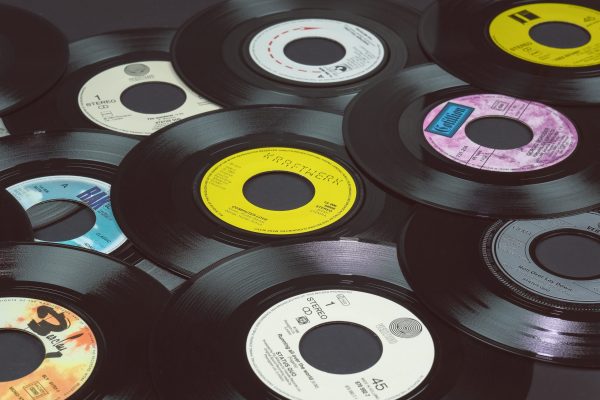
By contrast to the 33 1/3 RPM records, these 45 RPM records were manufactured on much smaller 7-inch records, almost half the size of larger 12-inch vinyl record types. The aim seems to have been to provide music listeners with a more transportable medium upon which to print more high-quality versions of album singles.
Seeing as the album didn’t even really become a seriously considered medium until the 1960s – other than in collating a bunch of unrelated singles – this medium rapidly became the currency for the exchange of popular music, able as it was to contain in a smaller format the content from an upcoming release.
Radio was still the go-to format for the discovery and exploration of all things popular and musical in this period. Many, if not all, popular radio hits of this period were, in fact, stored on 45 RPM 7-inch vinyl record types. Used in this way, the discs were only really, at a push, able to contain one or two songs per side, so the records quickly acquired the name ‘single’, which has since become the go-to term for the naming of a song that is released outside the bounds of a longer form release.
Once the 45 RPM 7-inch vinyl records and the 33 1/3 RPM 12-inch vinyl records became the common currency among music enthusiasts, it was these formats that record companies and manufacturers of turntable and record playing equipment began to focus all their efforts on, leaving such antiquated formats like the 78 RPM vinyl record in the dust, despite being such an inherently audiophilic format.
33 1/3 RPM
Soon, records that were intended to be played at 33 1/3 RPM became the standard currency for exchanging sounds between producer and consumer, remaining so to this day, with almost any turntable you can imagine offering the ability to play vinyl record types at 33 1/3 RPM.
Unlike the 78 RPM vinyl record format, however, this form of playback was a relative latecomer to the party, arriving at a time when radios were the primary source of musical and listening entertainment for most consumers. Thus, the 33 1/3 RPM format didn’t exactly have the smoothest start, though they were and still are relatively unparalleled, if only for being so effective at offering longer playback times on similar sizes of discs.
This has a two-fold effect, especially for record companies looking to maximize profits at every turn. More playback time on one record means fewer materials have to be used to achieve a healthy relationship of supply and demand, making them more money in the process.
By 1948, after a less than welcoming birth into the world, Columbia Records began advertising to the masses, heralding the 33 1/3 RPM record as a breakthrough in audio technology, able as it was to hold whole classical performance and symphonies on just one side of a 12-inch disc without the need to interrupt the listening experience to flip the disc.
Advertising it in this way, assimilating this format with the music of the western classical elite, instantly lent the format new standing in the music community, being able to hold what is considered by many to be the pinnacle of artistic achievement in the musical sphere.
Vinyl Record Types Based on Size
Just as there are variations in the speeds at which records are played, there are also different vinyl record types in the form of their very size and shape, which will be elucidated below, descending in size order.
For more detail specifically on vinyl record sizes, check out my full guide to vinyl record sizes here.
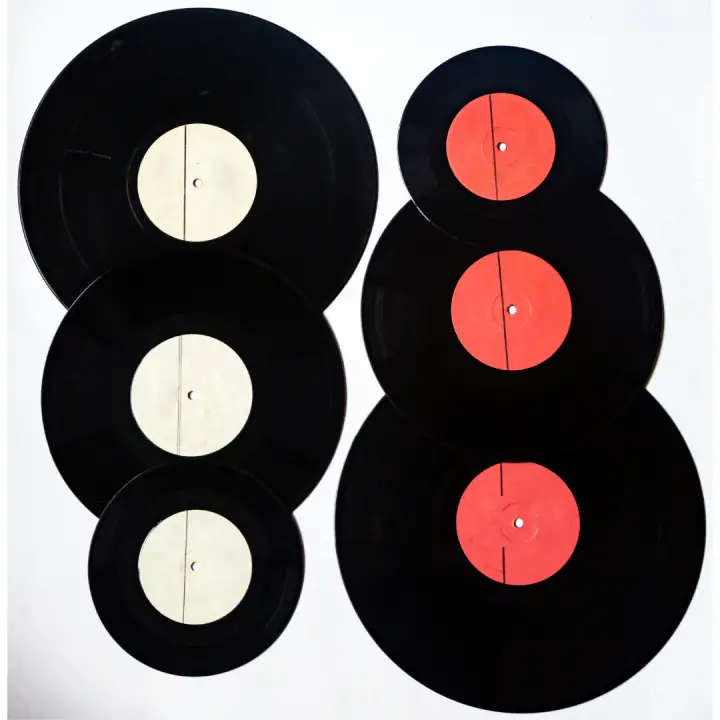
12 Inch Records
This size of record will more often than not house a recording of an album, typically one-half allotted per side of the physical disc. It is more often the case, also, that these albums will be played at 33 1/3 rpm, as this means there is more space on the record to contain the music which is being released in this longer form, able as a record is to hold roughly 15 to 22 minutes of music per side.
10 Inch Records
This will be one of the rarer types of record that you will encounter in the wild, excusing those kind of novelty or limited edition records mentioned previously, and one of those types of records that, as a guide to vinyl record types, I can safely say you won’t see as much of as its 12-inch and 7-inch brethren.
In being such a liminal size, many disregard its uses, simply seeing it as not very useful at all in fact. With a run time of 12 to 15 minutes at 33 1/3 rpm and 9 to 12 minutes at 45 rpm, there are no doubts as to the liminality of the medium. However, in an age where attention spans are getting shorter and shorter, this is perhaps not a bad thing.
7 Inch Records
The smallest of the more common vinyl record in this holistic guide to vinyl record types, this lack in size ought not translate to an overall lack of presence, for they can be found everywhere. Typically played at 45 rpm for the sake of audio quality, they are the perfect size for holding a single song on each side (depending on the length of the songs in questions of course), able to capture 4 to 6 minutes on each side, with the run time increasing to around 7 minutes if played at 33 1/3 rpm.
Why Do Vinyl Record Sizes Matter?
When it comes to vinyl records, size matters first and foremost because it determines playback length capacity. The greater surface area of a larger vinyl record equates to more groove length to etch audio information into.
LP, EP, and Single Formats
When browsing any record store or building your personal vinyl library, you’ll inevitably encounter the LP, EP, and Single designations attached to various releases. These terms denote the different primary record formats that the music industry has pressed vinyl releases onto over the decades. Familiarizing yourself with the distinctions around LP records versus EPs and vinyl singles will enrich your collecting endeavors.
Long Playing (LP) Records
The LP (long playing) record reigns as the quintessential full-length album format. Typically pressed on 12-inch diameter vinyl and played at 33 1/3 RPM, LPs allowed artists to create multi-track albums that flowed as cohesive creative works. Each side of an LP can hold a continuous 15-22 minutes of audio. This expanded capacity revolutionized the industry, taking albums beyond just collecting a handful of disjointed songs. Everything from formative 1950s jazz giants to the latest indie rock offerings primarily arrive as 12-inch vinyl LPs today.
Some key details around LPs:
- Originated as a viable format for longer classical compositions and full albums
- Typically contain 10-12 tracks spread across two sides
- Quality favored over portability with 12-inch size
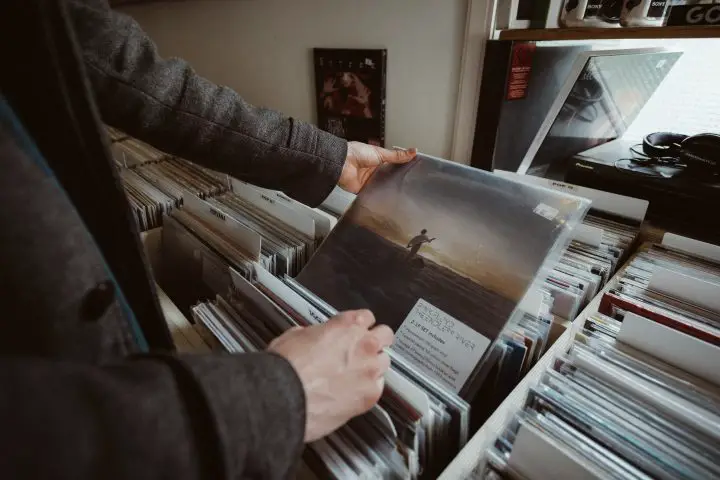
Double LPs
For especially ambitious album projects or live recordings capturing extended concerts, double LPs may be issued. As the name indicates, these consist of double the number of vinyl discs – so 2 LPs instead of 1. Each LP contains about 40-45 minutes of music, so combined a double LP release presents a sprawling 80+ minute runtime akin to a double album. Artists with lots of material to showcase will often opt for the double LP treatment. And labels can charge more given the extra vinyl and packaging required. For fans and collectors, double LPs can offer an even more immersive listening experience. Though one has to be extra careful not to accidentally play sides out of order!
Extended Play (EP) Records
Sitting between singles and LPs are EPs – extended play records typically issued on 7-inch vinyl at 45 RPM. As the name denotes, EPs contain more than the 1-2 songs of a single but don’t quite constitute a full LP length. Historically, EPs arose almost as mini-albums, often compiling early singles from a band before their eventual first LP release. They’d feature around 4-6 songs normally. Later periods saw more experimental use of the EP format for shorter concept works. EPs can make for more concise additions to a collection versus full LPs.
Single Records
7-inch 45 RPM single records contain the essence of vinyl in their short 1-2 punch song format. From early rock n’ roll ravers to 80s synth-pop hits and beyond, singles drove the pop culture zeitgeist for each era. For artists and labels, 7-inch records were the perfect platform for pushing a promising track and gauging potential listener interest quickly via an A-side lead single backed by a B-side song. Singles get right to the point by spotlighting a defining song you can absorb without flipping records. Their transportability also enabled the music’s spread through jukeboxes and personal listening. For many, singles offer the purest vinyl experience.
12” Singles
In addition to the standard 7-inch single format, 12-inch singles also emerged as a unique record type, often associated with disco, dance, and electronic music genres. As the name indicates, these are simply singles pressed on 12-inch vinyl records instead of 7-inch. The additional space allows for longer track lengths, extended mixes and remixes, and higher fidelity audio. DJs in particular prize 12-inch singles for their sonic capabilities and durability.Notable examples include the extended dance mixes of artists like Donna Summer and Kraftwerk that took advantage of the longer play time 12-inch vinyl offered. For any dance and electronic music fans, exploring 12-inch singles can unveil longer album versions of favorite tracks.
Other Vinyl Record Types
There are a few other more unique and less common vinyl record types that are worth mentioning in our guide. These specialty vinyl formats open up creative options for pressing one-off records, promotional releases, and custom shaped discs.
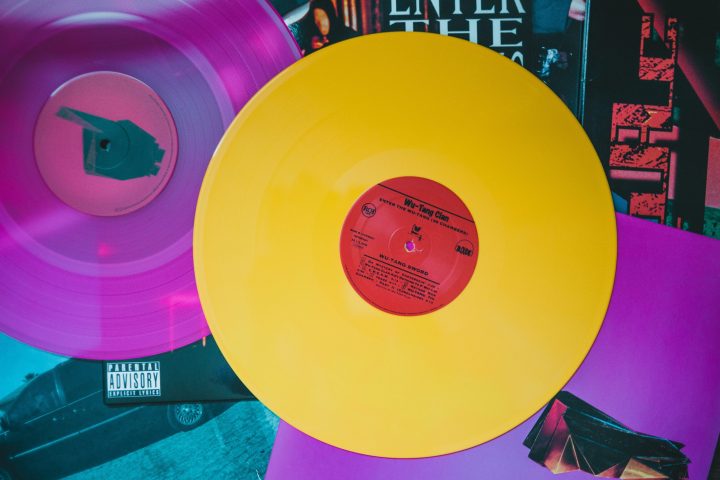
Flexi Discs
Flexi discs are a type of very flexible, vinyl records made from thin plastic instead of the rigid vinyl used for regular records. Introduced in the 1950s, flexi discs became popular for magazine or book giveaways and other promotional uses given their lightweight nature and ability to be mailed easily without breakage. The audio quality of flexi discs suffers from the thin format, but their flexibility allows creative packaging options like folding them into the spine of a book. Modern flexi discs are still produced today for special products or fan club releases.
Acetate Discs
Acetate discs, often referred to as acetates, lacquer discs or reference discs in the vinyl world, are a special type of record used primarily for quality control and reference purposes when pressing vinyl. They can only be played a limited number of times before deteriorating, but serve as useful one-off test pressings to preview music tracks and approve final mixes before mass production of vinyl pressings. DJs also use special acetate discs when scratching to avoid wear and tear on commercial releases.
Shaped & Colored Vinyl
While standard vinyl records come in basic black and the standard round format, there are actually many colors and even shaped variations of records available today. Colored vinyl has grown in popularity over the years, with special edition releases often coming in clear, red, blue or other vibrant colors. Shaped or picture disc vinyl can take even more exotic forms like heart shapes or elaborate pictures. This type of specialty vinyl tends to prioritize aesthetics over audio quality, but makes for excellent display pieces for avid collectors.
Final Tones
So, there you have it, the end to this brief, though I hope a comprehensive guide to the various vinyl record types, assembled so that you might be able to navigate the oft overwhelming world of vinyl collecting. Off you go, out into the big wide world!
FAQs Vinyl Record Types
What’s the difference between 33 45 and 78 records?
The central difference lies in the speed at which they are supposed to be played. A 33 1/3 record will need to be played at 33 1/3 rpm (revolutions per minute) in order to sound as close to intended as possible to the original recording. The same goes for 45 rpm records and the far less common 78 rpm record.
Are most vinyl 33 or 45?
Indeed, most vinyl record types you are likely to come across in the big wide world are going to be either 33 rpm or 45 rpm. It is still possible to come across vinyl record types that are played at 78 rpm, though it is far less likely; I certainly haven’t in all my years of collecting.
What are the three types of vinyl records?
There are two ways to categorise the various vinyl record types, either by size or by the speed at which they should be played, both of which traditionally come in threes. By size, there are 12 inch, 10 inch, and 7 inch vinyl record types. By speed, there are vinyl record types at 33 1/3 rpm, 45 rpm and 78 rpm.
What are the 3 sizes of vinyl records?
By size, there are 12 inch, 10 inch, and 7 inch vinyl record types, all of which ought to be playable on any standard issue record player or on any turntable attached to a decent stereo system.

